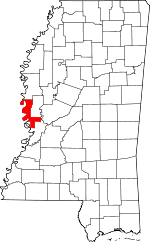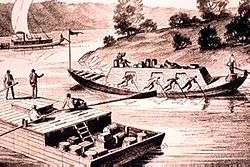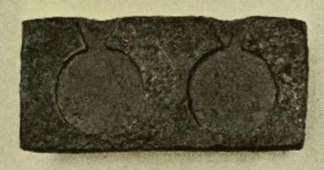Stack Island (Mississippi River)
Stack Island, also known as Crow's Nest and Island No. 94, is located in Issaquena County, Mississippi, in the Mississippi River, near Lake Providence, Louisiana and nearly 200 miles north of New Orleans.
| Geography | |
|---|---|
| Location | Mississippi River, Issaquena County, Mississippi, United States |
| Coordinates | 32.8°N 91.1°W |
| Length | 6 mi (10 km) |
| Highest elevation | 95 ft (29 m) |
| Administration | |
United States | |
| State | Mississippi |
| County | Issaquena |
| Demographics | |
| Population | (0) |



History
Beginning, in the late 1790s, the island became associated with river pirates and counterfeiting. Outlaws associated with Stack Island include; Samuel Mason, Little Harpe, and father and son counterfeiters Philip and Peter Alston.[1]
Island No. 94, or Stack Island, or, as it is sometimes called, "Crow's Nest." 170 miles above Natchez, was notorious for many years as a den for the rendezvous of horse thieves, counterfeiters, robbers, and murderers. It was a small island in the middle of "Nine Mile Reach." From thence they would sally forth, stop passing boats, murder the crew, or, if this seemed impracticable, would buy their horses, slaves, flour, whisky, etc., and pay for them.
In 1809, the last major river pirate activity, on the Upper Mississippi River, came to an abrupt end, when a group of flatboatmen, meeting at the head of the "Nine Mile Reach," decided to make a raid on Stack Island and wipe out the river pirates. They attacked at night, a battle ensued, and two of the boatmen and several outlaws were killed. The attackers captured 19 other men, a 15-year-old boy and two women. The women and teenager were allowed to leave. The remaining outlaws are presumed to have been executed.
The floods of 1811 and 1813, along with the 1811–12 New Madrid earthquakes, all but swept away the island leaving only a low sandbar.[2] From the 1820s-mid-1830s, John A. Murrell, the west Tennessee bandit, may have operated on the Mississippi River, not far from Stack Island.
References
- T. Marshall Smith. 1855. Legends of the War of Independence, and of the Earlier Settlements in the West. Louisville, Ky.: J. F. Brennan, Publisher. 342–344. Online at www.archive.org.
- E. W. Gould. 1889. Fifty Years on the Mississippi. 58–59. St. Louis: Nixon-Jones Printing Co. 58–59.
- Rothert, Otto A. The Outlaws of Cave-In-Rock. Cleveland, 1924; rpt. 1996 ISBN 0-8093-2034-7